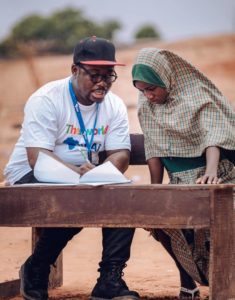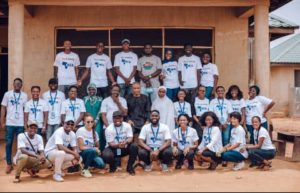By Promise Eze
WASSA, ABUJA: One evening in May 2017, suspected jihadists numbering over 20 and with military grade machine guns stormed the hilly town of Gwoza in northeast Nigeria’s Borno state.
Minutes before the shooting began, Aisha Garba, her parents and four siblings were having a peaceful dinner of baked corn flour with soup, but escaped to a nearby forest with other townspeople when the shooting erupted.
“I used to hear of Boko Haram and how they attack and kill people in villages close by. But I never expected that Boko Haram would attack my community one day,” 14-year old Garba recalled, grieving.
Members of the terrorist group, Boko Haram, had since 2013 captured towns across Borno State with Gwoza, a border town 135 kilometers south of Maiduguri, the state capital, with strong military presence, being one of their targets.
With push back from Nigerian forces, the insurgent’s attempt to capture the city failed. But it did not stop them from trying severally.
These repeated attacks forced the Nigerian government, in 2019, to evacuate Garba’s family and other townspeople to an internally displaced persons (IDP) camp at Wassa community in Abuja, the Federal Capital.
“I stopped attending school because Boko Haram kept attacking schools and we were always running from one community to another, looking for where is safer to hide from the terror group,” Garba said.
Besides directly killing about 35,000, Boko Haram, which is fighting to stop Western education and influence in northern Nigeria and establish an Islamic state, has destroyed 1400 primary and secondary schools and killed 2,295 teachers since 2009.
And its displacement of over 2 million people means the number of out of school children from Borno has jumped to 1.8 million – an increase of over 60% – over the past 13 years.
At the IDP camp in Wassa, Garba was enrolled into a makeshift school in a camp run by the government. But having been out of school for about three years before her new enrollment, she found it difficult to understand what was being taught. It did not help that her teachers in the camp were teaching her entirely in the English Language. Back in Gwoza, her teachers taught her in Hausa, the language spoken in most parts of northern Nigeria, with minimal use of English.
Like Garba, most children who had come to the camp from the northeast, north-west or north central regions of Nigeria due to either Boko Haram activities or bandits’ attacks on their community were facing the same problem of low comprehensive ability and language barrier.
The World Bank’s 2022 update on The State of Global Learning Poverty confirms that prolonged school closures and disturbances due to poor household incomes can make children up to 10 years old unable to understand simple written text. And while 70% of children from low and middle-income countries are affected globally, the number jumps to 89% among children in Sub-Saharan Africa.
Filling The Gap
Having observed the language gap in camp schools and the need to help camp kids gain functional literacy, numeracy skills and catch up with what they had missed during their out-of-school period owing to insurgency, in 2021, the Aid For Rural Education Access Initiative (AREAi), launched an initiative called FastTrack at six IDP camps in Abuja.

FastTrack uses a blend of three approaches. The first is a cluster system (“teaching at the right level”) that collects children of the same identified level of comprehension or learning needs, groups them into beginner, intermediate and advanced classes (rather than their age or pre-camp school grade) in preparation for learning.
It means a kid who used to be in primary two before coming to camp could be merged with another who used to be in primary five, provided their mental capabilities and comprehension levels are identified to be at the same level. Even though this grouping negates the conventional Nigerian (most age-pegged) system of primary 1-6 education system, it aims to foster unity of comprehension among children in each class.
The second step is to teach the children using an educational technology called the Mavis Talking Book and Pen and a dual language methodology of instructing the kids in both the English and Hausa languages. The Mavis Talking Book is a digital device that reads out text in Hausa and English when the tip of the pen that comes with it touches a text in the book.
The use of digital learning tools in classrooms increases the engagement of the children. It also helps teachers improve their lesson plans. Ultimately, it assists out-of-school refugee children build essential academic skills, according to Prince Gideon Olanrewaju, the Chief Executive of AREAi.
“The Marvis Talking Book and Pen fascinates the children because they can now learn at their own pace and can even do so while having fun. It makes them understand what their facilitators have been teaching them in the classroom. It’s a unique learning aid on its own. The children can make use of this book and pen even without the teacher being there. But the facilitators are only there to guide the children,” Funmilola Ahmadu, Senior Education Programs Manager of AREAi, told Social Voices.
AREAi launched the first phase of FastTrack in 2021. Since then it has provided basic and literacy skills to 2,500 beneficiaries in six IDP camps with access to alternative accelerated learning to assist them in developing their foundational skills, thereby reducing the number of children in Nigeria who lack access to learning and foundational skills.

The NGO works with about 250 volunteers/facilitators who spend about three hours, four days a week to facilitate learning in the various camps. By employing the Marvis Book and Pen which give instructions in English and Hausa languages,13-yr old Yohanna Zachariah, also an IDP from Gwoza, was able to identify and combine alphabets to form simple words in English.
“I couldn’t go to school when I was in Gwoza. The killings were too much. I know so many people that were killed. Even my uncle was killed. But I’m happy that despite all that has happened I could be given a chance to learn again. Now I can identify the English alphabet and also numbers,” he said.
The third is the dual language approach. This approach involves giving instructions in two languages—English and Hausa. Arguably, a lot of the children do not have a good command of English so it is imperative to blend English with their mother tongue so as to make comprehension easier and faster.
These are delivered in three phases. And one phase, which is equivalent to an academic session, lasts for 10 months.
Expert Speaks
Abubakar Kabiru, a senior lecturer with the Faculty of Education at Usmanu Danfodiyo University Sokoto emphasized that though the government is trying to provide education to out-of-school children, more effort needs to be put in so as not to leave the burden on NGOs.
“There are many things IDP children may need. Though the government is making some efforts to provide them with education, there’s still a yawning chasm between the intellectual capacity of IDP children and other children,” he argued.
But There Are Limitations
Despite the impacts of the FastTrack initiative, implanting the program comes along with challenges. One of them is insecurity. With the never ending insurgency rocking the length and breath of the country, heading to certain IDP camps may could be a suicide mission.
For some of the facilitators, language barriers could hinder free flow of ideas between the facilitators and the learners.
“I’m not fluent in Hausa. It makes it difficult for me to communicate with some of the children,” said Ayomiposi Sanmabo, a FastTrack initiative facilitator.
Another limitation is bureaucracy within the organization. Funmilola Ahmadu, Senior Education Programs Manager of AREAi stressed that it takes a lot of paperwork to get a project approved from the upper rung of the ladder in the organization. But for Aisha, the future holds a lot of promises. Though she’s still trying hard to improve on her English, she remains grateful that she could now catch up easily with what she’s missed over the years.
“Before the FastTrack program I could barely understand anything in English and I didn’t even know how to do simple arithmetic, but now I’m improving,” said Aisha, beaming with a smile.
This story was produced in partnership with Nigeria Health Watch through the Solutions Journalism Network, a nonprofit organisation dedicated to rigorous and compelling reporting about responses to social problems.















